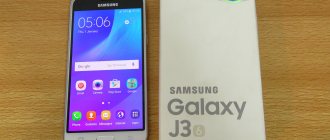Design and ergonomics
The external parameters of the M5 leave a pleasant impression. The phone is not too large and quite light. So it will be pleasant to hold it in your hand. The body is made of a combination of glass and metal. It is important that it is not slippery, and therefore many users will be able to avoid frequent falls of the device.
In terms of design, the developers decided not to come up with anything exotic and showed the world an almost complete copy of the well-marketed Samsung Galaxy 6/7. Here we also see an unusual side frame made of metal with a narrowing on the sides and widening towards the end, glass panels on the front and back, and an oval-shaped mechanical button right in the middle below the screen.
A grease-repellent coating is applied to the glass panels, and therefore the phone is not only non-slippery, but also non-marking. You can safely forget that the gadget stubbornly collects all fingerprints, losing its attractive appearance.
The body is made in the form of a monolithic block, and inside there is a non-removable battery. A non-hybrid side slot is provided for inserting cards.
In other words, you will not be able to choose whether to insert a SIM card or a memory card. Against this background, the lack of a separate slot for Micro SD is disappointing.
But the manufacturer has provided a solution to this problem by releasing the Xiaomi 5 32 Gb Edition along with 64 GB and 128 GB versions. Of course, there is a difference in price, but immediately upon purchase you can understand whether the gadget is suitable for the implementation of your plans or not. Note that the Mi 5 Standard comes with 32 GB of memory card and 3 GB of RAM. But the Xiaomi Mi 5 Pro model should be understood as the best package with 4 GB of RAM, 128 GB of memory and a ceramic case.
On the back of the case there is:
- The eye of the main camera, which does not protrude particularly, and therefore does not interfere with using the device in a horizontal position:
- A bright two-color LED flash that can also function as a flashlight.
At the front bottom of the panel there is a fingerprint recognition key that has already become familiar to Xiaomi in 2020. It no longer deserves additional description due to the widespread popularity of this function. Let's just say that the sensor works perfectly and without delays.
Here, at the bottom, there is the main speaker, next to which there is a USB connector. At the top, the phone has a headphone jack, as well as an infrared port in case the owner of the gadget wants to use it as a remote control for other devices.
There are only three color solutions for the design of the case: black, gold and white. They can be combined in any combination with a particular amount of memory on the card, and therefore you can buy both the Xiaomi Mi 5 128 Gb white or 128 Gb black, as well as the Xiaomi Mi 5 64 Gb gold smartphone and options in black and white, etc. .d.
Review of Xiaomi Mi5. A flagship on par with the Samsung Galaxy S7 at an average price
Not long ago, Xiaomi opened its first branded showroom in Moscow. Despite such a belated arrival on our market, this did not prevent it from taking a confident position and gaining recognition from users. The Note line of phablets is the most popular due to its affordable price and successful combination of characteristics. But they also have a flagship series with Xiaomi Mi5 at the head, the first smartphone released with the Snapdragon 820 platform. We will study this model using the example of the version with 64 GB of memory. There is also a version with 32 GB of memory, take this into account when choosing, there is no support for memory cards. Also at the time of release, Xiaomi Mi5 Pro was released with 4 GB of RAM and internal 128 GB of memory.
Even this series is almost twice as expensive as the flagships of Samsung, LG and Sony. For comparison, below is a summary table for the Samsung Galaxy S7 and Xiaomi Mi5 with similar characteristics, compiled based on data from the Yandex.Market service. Prices are from retail, but there is always the possibility of buying cheaper from large Chinese online stores.
Xiaomi Mi5 review
Equipment
Xiaomi Mi5 is supplied in a compact package made of light cardboard. All information is provided in the original language.
The package includes a charger supporting Qualcomm Quick Charge 3.0, a USB Type-C cable, documentation, and a clip for the SIM tray.
Appearance
Xiaomi Mi5 is available in several color options: snow-white, pink, gold and black. We are testing a dark version, an appearance worthy of the title of flagship. The imitation of a frameless screen, which is often found in 2020, is used. In reality, the thin side frames become visible when the screen is turned on. When you first look at the back of the case, associations arise with the design of the Samsung Note 5 with rounded sides.
This effect is complemented by the processing of the metal frame, the edges of which are ground at different angles.
The main area of the lid is glass. Fingerprints will collect over time, but are easily erased. The same general problem with sliding on an inclined plane, additional protective glass on the screen will not be superfluous. Plus, as an option, many cases with different textures and designs have already been released. In terms of ergonomics and build quality, there are no complaints about the Xiaomi Mi5. All parts fit perfectly together. No creaking or play of parts is observed. The official page states that the case is protected from dust and moisture, but the exact standard is not specified. We recommend not to take unnecessary risks by avoiding water getting into the connectors.
At the top end there is a connector for wired headphones and an IR sensor. Xiaomi Mi5 can be used as a universal remote control.
At the bottom there is a symmetrical USB Type-C, as well as a speaker and microphone grille with round holes.
The main camera lens is shifted to the side, next to it there is a dual LED flash.
Also on the lid is the logo class=”aligncenter” width=”750″ height=”477″[/img] The case is non-separable. The nano-SIM pair is installed in a tray that requires a key or pin to access. The power button and volume rocker are made of metal. Fixed tightly in the body, no play.
The design of the central mechanical button combined with a fingerprint scanner is also similar to Samsung. Speed and accuracy of work without any complaints. On the edges of it are touch buttons with spot illumination. Actions change in the settings.
On the top frame there are proximity and light sensors, a speaker grille, a front camera lens, and an LED indicator.
Protective glass Gorilla Glass 4 without the 2.5D effect; installing additional protection will be easy.
Screen
A 5.15 screen with an S-IPS matrix is installed. They did not participate in the meaningless pixel density race; Xiaomi Mi5 will delight the owner with Full HD resolution. There is no air gap between the protective glass and the matrix. Viewing angles are maximum. The illumination is uniform over the entire area. The color rendering is well adjusted. High brightness reserve and its adjustments are available. You can continue to work with the screen in direct sunlight. Supports 10 simultaneous touches. There are oleophobic and anti-reflective coatings.
Filling
The heart of Xiaomi Mi5 is the Qualcomm Snapdragon 820 processor, made using a 14nm process technology. Adreno 530 is responsible for graphics. Eight-core chip with 64-bit architecture. On board there are 3 GB of RAM and 64 GB of internal memory, without support for external drives. One of the most powerful phones at the time of release, all games can be enjoyed at high graphics settings. The software launches quickly, the interface works smoothly.
Antutu
Geekbench
3DMark
Connection
Xiaomi Mi5 supports Wi-Fi ac at 5 GHz frequency. The navigation module uses data from several systems at once, a cold start takes minimal time, and the positioning accuracy is high. The smartphone copes well with pedestrian and car navigation.
LTE supports the main spectrum of frequencies used by Russian operators. VoiceLTE has been implemented. There is NFC.
Battery
A 7.3 mm thick case houses a battery with a capacity of 3000 mAh. In actual use, this gives 6 hours of playback of high-definition movies. About 3.5 hours in gaming mode with the screen on. About 20 hours as a music player. In normal use, charging will last for the entire working day. Xiaomi Mi5 supports Qualcomm Quick Charge 3.0 technology, 70% of the charge is restored in about 40 minutes.
Camera
Xiaomi always pays a lot of attention to photo capabilities, offering the best solutions in its price segment.
Uses its own application with many settings and effects. The main module of Xiaomi Mi5 is made with a SonyIMX298 matrix with optical stabilization. The quality of the pictures is excellent, the smartphone will be a good alternative to digital cameras. The phase detection autofocus system ensures clear shots in motion. Sapphire crystal lenses. Selfie lovers will appreciate the 4 MP front camera with UltraPixel technology. Original photos from the Xiaomi Mi5 camera
Software
The Android 6.0 operating system with MIUI shell is installed. This shell is very popular and often acts as an alternative for many smartphone models. Alternative options for the smartphone itself have already been released. The program list window is combined with the desktop.
Customization and individual settings have been thought through.
Results on Xiaomi Mi5
Xiaomi Mi5 is a good option when choosing a flagship-level smartphone. The proposed level of performance easily copes with the tasks. You will also like the perfectly tuned display, support for two SIMs with LTE, loud speaker, metal frame, interesting cover design, IR port, gorgeous cameras with optical stabilization, support for fast charging, support for wired headphones, and a fingerprint scanner. The disadvantages include the lack of service in Russia and support for memory cards. There were no failures or problems recorded.
Screen
The phone has an IPS touch screen equipped with Gorilla Glass 4 protective glass. The diagonal is 5.15 inches with a resolution of 1920×1080. The side frames are minimal, and although this is not yet the promised frameless smartphone, the picture is displayed beautifully on it.
The brightness of the monitor is adjusted automatically using data from the light sensor. Thanks to multi-touch technology, the screen can process up to 10 touches simultaneously.
The viewing angles of the screen are quite good, and even if the view deviates significantly from perpendicular to the screen, there is no inversion of shades. The only possible negative is some oversaturation of color. You can correct this shortcoming in the Standart profile using the “warmer-colder” slider.
Taking into account the fact that the screen has anti-glare properties, you can take photographs using the gadget even on a very sunny day. On the other hand, even in complete darkness it is possible to reduce the brightness to a level acceptable to the user.
Xiaomi Mi5s smartphone - review
Xiaomi Mi5s smartphone - review
Xiaomi smartphones are usually very popular, mainly due to their very high-quality hardware. With firmware, things are much worse for them: often for some new model the official international firmware does not come out for a long time, so users are either content with Chinese firmware with English support, which they tweak with a file, or they install all sorts of custom firmware, which are almost certainly fraught with various glitches.
I reviewed the Xiaomi Mi 4 smartphone. That’s exactly how it was: good hardware and the crooked firmware. I jumped around a bit and eventually installed some custom MIUI in it, with which it lived quite well.
The new model Xiaomi Mi5, which was highly anticipated, never reached me, but now they sent me from Gearbest the newest model Xiaomi Mi5s, which just appeared. Moreover, on the store’s website it is separately noted that the International Edition MIUI 8 is installed here, that is, the official international firmware MIUI 8, which means that the smartphone should support the Russian interface without any problems and there should not be any glitches there.
Well, let’s figure out what this model and firmware are, especially since I haven’t seen detailed Russian reviews of this smartphone yet, there are only preliminary reviews based on the results of presentations.
Specifications
Operating system:
Android 6.0, MIUI Global 8.0 shell
Display:
5.15″, 1920×1080, FullHD, IPS, 2.5D, OGS, 427 PPI
Processor:
Qualcom Snapdragon 821 Quad Core 2.15GHz
GPU:
Adreno 530
RAM:
3 GB
Flash memory :
64 GB
Memory card:
no
Fingerprint scanner:
yes
IR port:
no
Network:
GSM+CDMA+WCDMA+TD-SCDMA+FDD-LTE+TD-LTE
Wireless:
Wi-Fi 802.11 b/g/n/ac , Bluetooth 4.2, NFC
Camera:
12 MP
Front camera:
4 MP
Ports:
USB-C (OTG), audio jack
Navigation:
GPS / A-GPS / GLONASS / Beidou / OTA
SIM card:
nanoSIM1 and nanoSIM2
Battery:
3100 mAh , non-removable, supports Quick Charge 3.0
Dimensions:
145.7 x 70.3 x 8.3 mm
Weight:
147 g
Additionally:
accelerometer, gyroscope, proximity and light sensors, Hall sensor
Housing colors:
white, black, gold, pink
Price:
on Gearbest $319 (about 20 thousand rubles)
Well, the characteristics are advanced, there is no trace of memory card support traditionally for the Mi series, we’ll see how it all works.
Contents of delivery
A dazzling white box in the style of “We also want to be like Apple”, on which two letters are pressed - Mi.
Inside everything is very simple, but neat.
The kit is in the style of “Only cheap smartphones come with all sorts of accessories,” so here is a power adapter with a Chinese plug and a USB-microUSB cable. They didn’t even include an adapter for a European socket, although the supply was like European. A trifle, but unpleasant. Smartphones costing $100-150 always include these. And an OTG cable. And a little case. And protective film. Well, because they’re cheap, what can you take from them!
The adapter supports three charging options.
Appearance and features
White plastic, rounded 2.5D protective glass, touch-sensitive Home button, which is also a fingerprint scanner.
The body is made of aluminum alloy, the left and right ends are noticeably rounded.
What does all this remind me of? And here's what - OnePlus 3. They're just twins. Only OnePlus 3 is bigger. Look - OnePlus 3 on the right.
Similar? Very similar!
The bottom end has a USB-C output, holes under which the speaker is hidden, and two decorative screws.
Here's OnePlus 3.
The left side is a slot for two nanoSIMs.
The top end is the audio output.
The right side has a volume rocker and a power button. Their pressure is quite distinct.
Well, here is this smartphone next to Honor 8 and Samsung Galaxy S7 edge.
The materials and workmanship are excellent, the smartphone makes a good impression. But the similarity to OnePlus 3 is confusing - I’m really interested in who is who and who has who.
The touch buttons “Return” and “Running applications” are not marked; they are backlit in the form of a dot that lights up for 4 seconds during use. (This is configurable.)
The “Home” button is touch sensitive; when touched, it responds with a vibration response and simulates a press.
Display
Display on an IPS matrix, made using OGS technology. Covered with protective tempered glass with rounded edges. Has an anti-glare filter and oleophobic coating.
The image quality is very good: the colors are bright and saturated, the contrast is at a good level.
The brightness reserve is quite sufficient. In direct sunlight the image is clearly visible.
Good viewing angles, with strong deviations the contrast drops slightly.
Device operation
As I already said, Gearbest claims that the official international firmware MIUI 8 is installed here, which is even stated in the title of the page of this phone on the store’s website.
And indeed, at first glance, the firmware looks like this: all Google services are in place, the Russian interface is practically without jambs.
However, if you go to the official website of the MIUI developer, it is easy to see that the Global Stable firmware for Mi5s does not yet exist in nature. Only China Stable, that is, Chinese firmware.
So what kind of firmware is installed here? Some kind of custom: either from multirom, or from xiaomi.eu, which make firmware based on MIUI. And the unpleasant thing is that this firmware persistently works under MIUI Global Stable 8.0 (as it is written in the MIUI version of the smartphone), but such firmware does not yet exist in nature, as the developer himself claims. However, in the abbreviation MAGCNDH in brackets next to the version number, the letters CN actually mean “China”, that is, this is Chinese stable firmware, modified by craftsmen.
It will appear, of course, because it exists for Mi5, but now it is not there.
The question arises: why worry about the fact that this is custom and not the official international one, if everything is in order with the firmware and everything works stably with it? So the problem is that there are some minor problems with stability, and I will write about this in detail below.
Main desktop.
Second desktop.
Applications in the Tools folder.
Lock window.
It also comes with an audio playback widget.
Quick switches scroll only horizontally - this is not very convenient. However, this is installed by default, and in the notification settings you can separate the notification window and quick toggles - then the quick toggles will be in a separate window.
Phone application
Incoming call.
Talk mode.
The quality of telephone communication is good, noise reduction works quite effectively.
Wi-Fi transmission speed is close to maximum.
Mobile Internet reception is even better than expected for these conditions. Transmission is normal speed.
Audio
The sound of the built-in speaker is decent. Not as “flat” as usual, but at the same time slightly dull. At full volume there is no rattle, the volume margin is normal.
Sennheiser CX 2.00G in-ear headphones are good: the sound is clear, detailed, good highs and even some bass.
Full-size headphones Audio-Technica ATH-M50x - very good: the sound is spacious, clear, detailed, deep bass, clear highs.
Determining coordinates
It starts very quickly (a couple of seconds), detects GPS and GLONASS satellites. It holds the road well, there were no problems with the navigation programs.
Games
The platform is powerful, any games run smoothly and at maximum quality settings.
Asphalt 8 runs very smoothly, FPS stays at 30.
Tanks - almost all the time 59-60 FPS, that is, the maximum.
Epic Citadel performance test - also FPS at maximum.
Settings
There are many interesting features in the settings.
You can adjust the font size, enable reading mode, and turn on the screen by double-tapping (which, by the way, did not always work the first time).
Themes. By the way, there are a great variety of free themes available - for every taste.
You can create a separate data space for a second user.
Of the 64 GB, almost 58 GB are free for the user.
Child mode is a useful feature for some users.
Setting up the indicator.
There is an equalizer adjustment for different types of headphones, but I would not say that this leads to a good effect: for me, the sound is better without an equalizer.
This is what I really like - customizing the location of the navigation keys and various actions when pressed and long pressed.
Adjusting the backlight of the keys.
One-handed operation, and you can “tailor” it to three display sizes.
Enable dual mode for selected applications. This is when two copies of an application are stored with different settings. For example, if you need to work with Facebook with two different accounts, you can enable this here.
You can password protect individual applications.
Setting up a fingerprint.
Camera
Simple interface.
Shooting modes. The second window shows night mode.
Camera settings called up using the “Menu” button.
Examples of photos. (All are clickable and open in full size.)
Daylight indoors.
Street on a sunny day.
Example text.
Evening, at sunset. 500 ISO.
In the dark, it resolutely sets ISO 6400 and at the same time blurs out the noise. But the result is not that much pornography.
Here's a 1:1 crop.
And if you turn off the noise reduction mode (there is such a thing in the settings), then it turns out something like this.
Example video.
What can I say about the camera? The camera is decent for the price of the smartphone. Detail and dynamic range are good, white balance is determined more or less accurately and hardly fluctuates, exposure is determined normally, autofocus, although far from being as “tenacious” as competitors’ flagships, there are few defects there. Focusing does not work well in difficult lighting conditions (it happens that it simply cannot focus even on a dimly lit object), the quality of images in poor lighting conditions is much below average, but not terrible.
It shoots video well, and when shooting video, the stabilizer clearly works and improves the quality of the video.
OnePlus 3 has a noticeably better camera, but it still costs one and a half times more.
So, in general, the camera is normal for a smartphone of this price, in my opinion.
System data and performance
CPU-Z data.
Performance rating according to AnTuTu. Top ten fastest smartphones. Moreover, it even seems to overtake OnePlus 3, which did not hold the championship of the fastest for long. However, it is clear that now smartphones from the top twenty AnTuTu are all very fast.
Indexes according to Geekbench 3.
Well, the overall score according to PCMark. But OnePlus 3 has 7003!
Battery life
Battery 3100 mAh. However, I had problems with the tests here. I was unable to run either the web browsing test or the PCMark synthetic test. Why?
Because when I tried to set “Never” to turn off the screen in the settings (there is such a thing), the smartphone gave me an error and did not set this mode. Well, no problem, I can install a program that will not allow you to turn off the screen (in fact, I usually use these when testing the Internet for battery drain). But no, none of these programs worked. More precisely, it worked, but the screen still turned off.
Well, the PCMark test turned out strange. It just froze at some point, while the smartphone was actively consuming energy, and then at some point it declared that it was low and suggested turning on the power saving mode.
Therefore, I really only tested the video viewing mode.
Video.
Wireless communications are disabled, the player's brightness is set to a comfortable level of 10 (15 in total), and the MX Player plays a video series in a loop. And here it turned out to be as much as 18 hours and 15 minutes! (OnePlus 3 has a similar duration - 17 hours 35 minutes.)
So we can assume that the Internet here will last about 10 hours and 30 minutes, and PCMark would give about nine-odd hours - similar to OnePlus 3.
Purely with a mixed load, the smartphone confidently lasted for about a day and a half.
When fast charging, the smartphone consumed about 2 A, so a full charge from zero lasted about an hour and forty-five minutes.
Observations at work
I have already written about small glitches associated with this custom firmware: the “Never” mode for turning off the screen was not set, the screen turn-off locking programs did not work, the PCMark program froze when testing battery life (this is the first time I’ve seen this).
Another slight sadness is that OTG does not work in this firmware. Although the device itself, judging by the specifications, supports OTG.
To understand what other problems there might be with this firmware, I wasn’t too lazy, installed my usual programs and ran them. Fortunately, they all worked fine, I didn't notice any other glitches.
Regarding heating, the platform is powerful - even when running heavy 3D games, almost no heating was observed. Literally once I noticed a slight heating in a situation where I was loading a bunch of programs and data for them in a row. Slight heating was also noticeable when playing high-resolution videos.
The fingerprint scanner worked correctly and crashes were rare. By the way, interestingly, the scanner also worked fine on wet fingers. He fooled around with the dirty ones, but worked with the wet ones. Later I read that there is a new type of scanner and water is not an obstacle to it, which is valuable.
Using the touch-sensitive Home button, which signals when pressed by vibration, turned out to be quite convenient. You get used to it quickly, and then when you return to the physical button, like, for example, the Samsung Galaxy S7, it seems that the physical button is less convenient.
What is the result? In terms of hardware and characteristics, the smartphone is excellent. The only pity is that there is no official international firmware for it yet, but it will probably appear soon.
The existing custom firmware that is installed in Gearbest is very decent (and sometimes they are just wild), but it has some glitches, which, however, do not interfere with normal operation.
Well, I think that with the official firmware the smartphone will be one of the best in its class. It's very similar to the OnePlus 3, only that one costs $470 on Gearbest, while this one costs $319.
Sound
Sound is not initially considered the trump card of either Xiaomi Redmi or its older flagship brother. In this component, there is a clear lag behind Meizu or Huawei. There are problems with both volume and frequency spectrum, and you certainly shouldn’t experience the device operating at maximum volume, because the sounds literally merge. By the standards of an average player, the sound is passable, but from the leader of the line I would like something more.
But there are no complaints about the quality of the speaker and microphone. There are no unnecessary unpleasant noises detected, and it is pleasant to have a telephone conversation.
Design
In appearance, the Xiaomi Mi 5S is very similar to its older brother Mi 5, but in reality everything turns out to be much more interesting. Glass on the back, which can be difficult to handle due to being slippery, is a thing of the past. It has been replaced by stylish brushed aluminum. It not only increased the comfort of use, but also gave the device aesthetics.
Thanks to a slight curve on the back, the smartphone fits perfectly in the hand, and the slightly distorted 2.5D glass on the front adds a plus to ergonomics. A small disadvantage compared to Mi 5 is the increase in the weight of the gadget by 16g due to the use of metal.
The Xiaomi Mi 5S phone does not have navigation buttons marked, which allows the owner to set an individual configuration through a special menu. The button in the center serves as a fingerprint scanner.
The power and volume control keys are conveniently located on the right side.
At the top there is a 3.5 mm headphone jack, and at the bottom you can find a USB Type-C port, a main speaker grille and a microphone.
On the left there is a port for two SIM cards, but this device does not provide the ability to expand the memory using microSD.
Various LEDs and sensors, as well as a camera and speaker for conversation, are conveniently located above the screen.
Camera
For Mi 5, a review must include a review of the camera. The main camera has a resolution of 16 megapixels, and the front one has a resolution of 4 megapixels. There are traditionally no high expectations from the front camera, but the main camera turned out to be just right. Here you have an optical stabilization system, phase fast autofocus and the ability to make manual adjustments to the system’s operation. Among the original modes, we highlight panoramic and fisheye. If we put a full review of the camera into a list of specific advantages, we will name the following:
- Excellent detail in shadows and midgrounds;
- Sufficient sharpness across the entire field of the frame;
- Good texture development;
- Slow loss of sharpness as the shot is removed;
- High quality indicators for macro photography.
In a word, if you decide to buy Xiaomi Mi 5 gold, then you will admire the camera perhaps most of all. This is a truly flagship level, and it is clear that the developers paid sufficient attention to every detail. Therefore, such a phone will easily and efficiently perform artistic or documentary photography.
Software
“Five” runs on the Android 6.0 platform in the Mi UI shell from Xiaomi. This operating system is well known to fans of the Chinese manufacturer, because the same combination was already, for example, in Xiaomi Redmi Note 3. As usual, the platform gives the user maximum freedom of action, and among the available functions:
- Reducing the screen area for one-handed operation;
- Changing font size;
- Customize your own theme;
- Setting the length of time you press a key;
- Selecting the color of the light indication;
- Switch to guest and child modes.
I especially like the fact that as standard the device has a minimum of pre-installed programs, and even then among them only those vital for the operation of the phone. Therefore, we don’t have to be indignant about the excessive clutter of the gadget, and if necessary, we can easily install any necessary application on it.
You just don't know how to cook it...
Due to the fact that MIUI is a “thing in itself”, some users may have questions and even irritation. For example, by default the system is configured so that you cannot install applications from Google Play over 3G - to enable this feature you need to look in the settings of the “Downloads” application. Due to power saving settings, Push notifications and so on may not be received - newcomers to MIUI who want to figure out what's what will most likely have to look at thematic forums.
A separate topic is firmware. There are “Chinese” and “global”. The first ones are installed by default on almost all devices, they have only two Chinese languages and English, there are no Google services, the Cyrillic alphabet does not look as beautiful as the Latin alphabet, there is a set of pre-installed programs for the Chinese market. You can live with such firmware, Google services are installed in “a couple of clicks”, you can install a theme with a suitable font, and so on. Based on these firmwares, localized versions are created from fan communities (MIUI.su, MiuiPro, miui.eu) - the developers remove unnecessary software, add localization and Google services.
“Global” firmware contains a full set of system languages, Google services, and has fewer unnecessary programs aimed at the Chinese market. In general, using a Xiaomi smartphone on “global” firmware is not much different from using a Samsung purchased at Allo. Among the manufacturer’s smartphones, there are models (Redmi Note 2, Mi4i, Redmi Note 3 Pro) that are officially sold not only in China, but also in India - for them, as a rule, there are “global” firmware from the manufacturer.
Both types of firmware are available for Mi 5 and both, at the time of writing the review, contain a sufficient number of glitches that affect the comfort of use to varying degrees (the most annoying of those noticed is the poorly functioning auto-rotate display in YouTube, and the Home key and fingerprint scanner do not always work). Almost all Xiaomi devices are “damp” at the start of sales and the company spends a couple of months to bring them to perfection. Instructions for flashing (if necessary) can be found on thematic forums. We can say with confidence that later CyanogenMod, AOSP and other builds will also appear for the smartphone. Such nuances of use should be taken into account when choosing Xiaomi.
4.5
ITC.UA rating
Pros: Case design and materials, hardware, NFC and infrared port, two SIMs, screen and cameras.
Cons: The firmware is still damp, the availability of body colors and modifications, there is no slot for a memory card
Conclusion: Xiaomi managed to “correctly” update its flagship. Mi 5 is perceived as a competitor to A-brands, although with traditional reservations, which include possible difficulties with firmware, crude software at the start of sales, a wide range of prices and the availability of older versions of the smartphone. Otherwise, if you know how to deal with these difficulties and are ready for them, Xiaomi Mi 5 will please you. In addition to the traditional flagship hardware, for minimal money the company was able to create a beautiful smartphone with good ergonomics, and that’s worth a lot. In every sense, the device turned out to be long-lasting - at least after six months or a year it will also be an attractive purchase. Therefore, as a good smartphone option for advanced users, it gets our Editors' Choice.
Specifications
| Xiaomi Mi5 3/32GB White 6954176860477 Notify when on sale | |
| Type | Smartphone |
| Pre-installed OS | Android 6.0 |
| RAM, GB | 3 |
| Built-in memory, GB | 32 |
| Expansion slot | — |
| SIM card type | Nano-SIM |
| Number of SIM cards | 2 |
| CPU | Qualcomm MSM8996 Snapdragon 820 |
| Number of Cores | 4 |
| Frequency, GHz | 1,8 |
| Battery | Li-Po, 3000 mAh |
| Diagonal, inches | 5,15 |
| Permission | 1920×1080 |
| Matrix type | IPS |
| PPI | 428 |
| Dimming sensor | + |
| Display Features | Color gamut 95% NTSC; Screen brightness 600nit, contrast ratio 1500:1 |
| Main camera, MP | 16 |
| Video shooting | 1920x1080 pixels |
| Flash | LED |
| Front camera, MP | 4 |
| Camera Features | Sony IMX298 sensor, phase detection autofocus, 4-axis optical image stabilization, dual LED flash, DTI technology, sapphire glass protected lens, video recorded in 4k, HDR support, panorama; front camera with 2 micron pixel size |
| Communication standards | 2G (GSM 850/900/1800/1900), 3G (HSDPA 850/900/1900/2100), 4G (LTE, 1800/2600), 4G+ LTE-Advanced (600 Mbps) |
| WiFi | 802.11ac |
| Bluetooth | 4.2, A2DP, LE, Bluetooth HID |
| GPS | + (A-GPS, GLONASS, BDS) |
| IrDA | + |
| FM radio | — |
| Audio jack | + |
| NFC | + |
| Interface connector | USB Type-C |
| Height, mm | 144,6 |
| Width, mm | 69,2 |
| Thickness, mm | 7,3 |
| Weight, g | 129 |
| Protection from dust and moisture | — |
| Type of shell | monoblock (non-separable) |
| Housing material | metal/glass |
| Keyboard type | screen input |
| More | fast charging support, fingerprint scanner |
Performance
The main thing you need to know about the performance of Xiaomi Mi 5 is that the model is developed on the basis of the most powerful Snapdragon 820 chip from Qualcomm today, which is many times faster than its predecessor Snapdragon 810. The configuration assumes the presence of four 64-bit cores with a maximum frequency of 2 .2 GHz. High quality graphics are provided by the Adreno 530 GPU.
It is not surprising that the results of all kinds of tests are close to the maximum. In terms of graphics, only the elite Samsung Galaxy S7 Edge can compete with the “five” competitors. So this gadget is a real gift for gamers, because you can enjoy an excellent and non-freezing picture for hours. With all this, the heating of the rear panel is not particularly noticeable even after a long game.
Hardware platform
Xiaomi traditionally uses top platforms from Qualcomm in its flagships. This time the choice fell on the Snapdragon 820 (MSM8996) – a quad-core SoC with proprietary Kryo cores and Adreno 530 GPU, made using a 14 nm process technology.
Mi 5 is available in several modifications, differing in the amount of RAM and permanent memory, as well as SoC frequencies. The basic version we visited is equipped with 3 GB of RAM, 32 GB of ROM, Snapdragon 820 frequency formula: 2 x 1.36 GHz + 2 x 1.8 GHz. The “medium” version is equipped with 3/64 GB of memory, processor frequencies are increased to 1.6 and 2.15 GHz, respectively. The processor of the “older” version operates at similar frequencies, but the memory capacity is expanded to 4 and 128 GB, respectively. Naturally, there is a dual-band Wi-Fi module with support for the 802.11 ac standard, Bluetooth 4.2 LE, GPS/Glonass/Beidu for navigation, an infrared port for controlling household appliances and an NFC module. The USB Type-C port (USB 2.0 standard) is used for charging and data transfer.
During testing, I had no complaints about the operation of Wi-Fi or GPS. The overall speed of the smartphone corresponds to the title of flagship, although slowdowns due to damp software sometimes occur. One of the unpleasant features of devices on the Snapdragon 810 was the heating of the processor, and therefore the case. Judging by the Mi 5, the Snapdragon 820 turned out to be cooler. During normal use, the smartphone remains cold or barely warm. Under load, the heating is slightly noticeable, but it is much less than that of the previous generation SoC, the platform does not lower clock speeds under load (no throttling). After four launches of Antutu, the result remains the same – about 110 thousand points. If you then shoot another 6 minutes of 4K video, the processor will warm up to 40 degrees (this is a good result, devices on the Snapdragon 810 heated up to 50 degrees and above). There is no need to talk about performance in games - Qualcomm flagships have good optimization, games run without stuttering at the highest graphics settings (57-60 fps in WoT).
The smartphone has a fingerprint scanner integrated into the mechanical Home key. It works well (relatively quickly and accurately), but the small sensor area still has an impact: you have to scan fingerprints more carefully, apply your finger more variably at the time of registration and more evenly during use. The scanner does not recognize wet, swollen fingertips. In general, the fingerprint sensor works in about 85% of cases - not bad, but there are better implementations.
Battery
The gadget has a non-removable battery with a capacity of 3000 mAh. And this is quite enough to ensure a long life without charging for this device, which is not so large in size. This figure is not a record even within the Mi line, but in combination with the unconditionally best characteristics it looks very decent. For example, a smartphone can withstand up to 20 hours of continuous reading and about 6-7 hours of 3D games in a row.
It’s also nice that charging is extremely fast – using a native charger it will take less than an hour and a half.
Give gifts
Fitness bracelet Xiaomi Mi Band 4 Silicone strap as a gift!
2 490 ₽
Fitness bracelet Xiaomi Mi Band 3 Silicone strap as a gift!
990 ₽
In progress
The Xiaomi Mi 5S is powered by a new Snapdragon 821 processor. The developers artificially lowered its frequency to 2.15 GHz, but, probably partly thanks to this, the smartphone boasts excellent battery life - one full charge of the battery (3200 mAh) provides it with nine hours of playback video or seven and a half hours of continuous active work (Internet, photo editing, typing, and so on).
In benchmarks, Xiaomi Mi 5S shows excellent results: in AnTuTu it scores more than 133,000 points.
This is not a record result for this test, but the Mi 5S is sold far from the flagship price. The smartphone is equipped with very fast memory - downloading and installing applications takes just seconds. There are two versions of the device: one with 3 GB of RAM and a 64 GB drive (we tested it), and the other with 4 and 128 GB, as well as support for 3D Touch Display technology. There is no 32GB version, which is correct given the lack of memory card support. Xiaomi Mi 5S is very fast and can handle even complex games well. In the racing simulator Real Racing 3, which is very close to reality not only in physics, but also in graphics, all the textures and highlights are in place, and the body almost does not heat up during the game. The only thing missing is the speaker power - after all, sound is very important in realistic racing.
In the beloved game World of Tanks Blitz, the gadget at maximum settings calmly keeps fps at 50-60 with rare dips to 20-30, which ensures a smooth picture and convenient gameplay.
The smartphone supports two SIM cards, both nano format. The Internet works great, despite the lack of Band 20. There is support for GPS and GLONASS navigation systems, as well as Wi-Fi 802.11a/b/g/n/ac, Bluetooth 4.2 and NFC interfaces.
Conclusion
Having understood in detail the features of Xiaomi Mi 5, you understand that this is a qualitatively new product in the line, significantly ahead of competitors in the price segment. It is productive, powerful, equipped with an excellent camera that allows you to perform a wide range of tasks, and at the same time has excellent autonomy. Even taking into account the fact that the sound by flagship standards could clearly be better, there is simply no worthy alternative to the Xiaomi Mi 5 in terms of price and quality. It seems that with such characteristics the phone will be relevant for a long time, and the demand for it will please Xiaomi manufacturers who have done their job well.
Where to buy Xiaomi Mi 5
Since the end of 2020, an official Xiaomi representative office has appeared in Russia, where you can buy absolutely any licensed model of a gadget from this manufacturer. In official stores, the phone will have localized firmware, an interface in Russian and charging with a plug that is familiar to us.
But the obvious disadvantage is the price of such a gadget. In practice, it is one and a half (or even more) times higher than when purchasing in an online store. Therefore, here you have to choose: either overpay, but get a gadget already adapted for use in our country, or take risks with a purchase without guarantees and the possibility of getting a fake, but at a much lower price.











